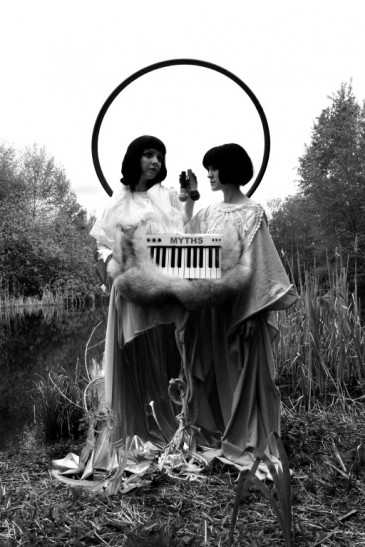
Pop culture has taken a decidedly darker direction in the past few years. This trend has manifested itself lately in a widespread fascination with the occult. Cryptic, creepy videos like Jay-Z’s “On to the Next One” have been accompanied the pervasive Jay-Z-as-Illuminatus theories. Clothing labels like Mishka and Actual Pain have brought horror-movie imagery to the mainstream. Witch house, championed by buzz magnets Salem and Mater Suspiria Vision, is the nascent boutique genre of 2010.
We’re starting to see effects of this shift close to home. One group that’s reacting to this change is Myths, which recently emerged from the ashes of seminal Vancouver noise-punks Mutators. Ostensibly, they’re products of the witch house movement, and to an extent, they embrace that label. Yet they insist their vision is radically different than other groups under witch house’s black umbrella.
Of the two members of Myths, Lief Hall and Quinne Rodgers, neither had heard about witch house until it was brought up in our interview. I couldn’t blame them. Their music, while employing a couple common tropes of witch house—wavering acid synths and pounding drum-machine beats—steers clear of witch house’s syrupy drone. They also display a fondness for vocalizing that most witch house artists lack. Their experiments marry the panicked shriek of Mi Ami’s Daniel Martin-McCormick with the pained wail of AIDS Wolf’s Chloe Lum. In other words, they sing harsh.
But as I described some of the main qualifiers of the witch house scene: the abstract symbolism, the focus on visuals, the intuitive creation method—they found plenty of thematic commonalities. They make an active attempt to harness the power of the symbol—“They do have a power behind them, and people need to take it back,” said Hall. They see visuals as central to the art they create—“It almost affects people more than audio a lot of the time,” said Rodgers, who also acknowledges how art needs to be spontaneous and intuitive. “Meaning evolves through creation,” she said. “With art, it just feels right, and creates meaning that we didn’t necessarily know about.”
But there’s a certain idiosyncrasy to their creation method. While they play up these elements in their art, they also shy away from total abstraction. “We totally think through everything we do. Everything has absolute meaning and purpose. Everything we do is meant to be examined. It’s there for the purpose of creating a dialogue.”
It’s difficult to decipher any clear themes in Myths’ musical cacophony. If anything, their music suggests a surrender to the abstract. “You’re not real; you’re not really real,” they howl on “Deadlights.” But it’s hardly fitting to take lyrics like that at face value. There’s more to Myths than croaked-out lyrics and fuzzy synths. Although they insist that every aspect of their art is carefully managed, it’s tough to imagine they carefully thought through their shrieking patterns.
They differ from many witch house artists as well, in that they get out of their bedrooms once in a while to play live. In fact, while most witch house acts are content to hide behind a mask of online anonymity and drop EPs on Mediafire every now and then, Myths has one piece of public material to their name, a four-track mini-CD that is exclusive to their merch table. While they have a clear musical vision that, on some level, they try to carefully craft, the spontaneity of their live performance is their raison d’être.
Their relationship with witch house is most curious upon examining their relationship to witches. While witch house’s view of witches owes its greatest debts to Dario Argento’s lurid Mother of Tears trilogy and occult Hammer gems like The Devil Rides Out, Myths has a personal connection with witches: Hall’s mother is Wiccan. Although she didn’t start researching Wicca until a couple years ago, she draws most of her perspective on the occult from Wicca’s earthy neopagan roots rather than Argento’s cryptic evil—although she does admit to being a big Suspiria fan.
Over the course of the interview, Hall is most enthusiastic when discussing how Myths attempts to deconstruct darkness. She cites an American study that found children to have universally negative, fearful perceptions on witches and ties it to a fear of strong women. It’s times like this when that clarity of thought Hall mentions really shines through. Myths might make abstract music, but it’s certainly rooted in concrete ideas. Both Hall and Rodgers have strong feminist ideals, and when taking this into context, their elaborate act, complete with stage costumes, improvised noise and larger-than-life imagery, kind of starts to make sense. They’re trying to reclaim the idea of witches. They’re trying to recontextualize darkness.
“Everything we used to sing about was so negative. We deal with negative issues, but we try to create a positive response to them. The music might not come across as positive, but it’s about addressing issues, seeing things for what they are, knowing you’re strong enough to deal with them, or whatever.”
“Or whatever–” this lack of verbal clarity is what I’ve come to expect from Myths—and that’s not necessarily a bad thing. Myths may not be able to articulate their grand vision on stage, but whatever indeed. Their resistance to conventional classification makes their vision all the grander.

